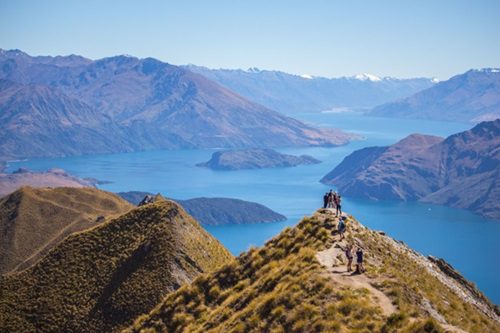The post-pandemic world has presented a complex set of challenges for the global tourism industry to contend with in recent years. Slow economic recovery, shifting travel preferences and a cultural rethink on the feasibility of mass tourism have all impacted a once-thriving international sector. In New Zealand however, a nation with one of the strongest and most immediate responses to the global pandemic, the tourism industry now finally appears to be in recovery. While still not matching pre-pandemic levels, the industry has established itself as the country’s second-largest export with a total tourism expenditure of $37.7 billion in 2023 only narrowly lower than the $40.9 billion in 2019.
Following the launch of a new four-year strategy by René de Monchy, chief executive of Tourism New Zealand, the country is targeting $5 billion worth of growth in the tourism sector by 2028. Just how is this Pacific island looking to achieve this?
Focus on Growing Off-peak Visitation
Like many tourism hotspots around the world, old patterns are returning with the majority of visitors to New Zealand now planning their trips during the peak season in the summer months. The main issue with such disparity across the year is that many businesses in the sector struggle to operate efficiently all year round, over-reliant on a hectic peak period. While seasonal fluctuations are difficult to eradicate completely, the New Zealand Tourist Board is focusing its efforts on growing off-peak visitation numbers. By showcasing the country’s off-peak experiences, like skiing and traditional cultural events, it is hoped that many visitors will be enticed by the alternative opportunities on offer. Furthermore, it is suggested that by visiting in off-peak periods, the lack of overcrowding in popular destinations should in fact enhance the experience for visitors. With 70% of the targeted $5 billion growth expected to come from off-peak visitation, this is one of the country’s key strategies for boosting tourism.
Taking Advantage of its Natural Wonder
New Zealand boasts a wealth of diverse natural wonders and eye-catching landscapes that few other destinations can claim to possess. Whether it’s the awe-inspiring beauty of Milford Sound or the staggering peak of Mount Cook, this small island nation is a bucket list destination for nature lovers and those looking for adventure. Taking advantage of the abundance of natural destinations in New Zealand has been an important aspect of tourism in the country for decades, however, the country is continuing to expand on its adventure tourism industry. Traditional outdoor activities like hiking, skiing and camping all continue to be popular with visitors, on the other hand, more extreme experiences like bungee jumping and skydiving are increasingly on offer in many parts of New Zealand. As a serene and sparsely populated region, the country is also tapping into the wellness craze that has emerged in recent years, with a plethora of wellness retreats and health-focused experiences now available.
Diversifying Tourism
While the nation’s reputation as a nature enthusiast’s paradise is well established, the post-pandemic era has seen the industry diversify into new areas in order to attract a broader visitor demographic. The development of certain entertainment industries, such as iGaming, has established new avenues, bringing in new types of tourists. Websites like Casino.org ranks NZ pokies to make sure visitors can find the best quality online platforms when in New Zealand. Furthermore, the rich history of the indigenous Maori culture has received significant support from the tourist board in recent years, with multiple cash injections being invested to help support Maori Tourism. As one of the oldest living cultures anywhere on the planet, the Maori people and way of life are unique to New Zealand and learning more about this culture is becoming part of the itinerary for many international visitors.
Modernising the Country’s Infrastructure
A successful tourism industry requires high-quality supporting infrastructure like transport links, accommodation and high-speed internet to ensure it can operate efficiently and effectively. Investment in such infrastructure has been high on the agenda in New Zealand, as while many of the main cities possess a wealth of hotels and hostels and excellent public transport systems, many of the country’s regional areas are lagging behind. This is highlighted by the fact that New Zealand has one of the lowest rates of public transport in the world. However, in December of this year, the Kiwi government is set to launch the National Infrastructure Agency (NIA), marking a shift in the country’s approach to infrastructure planning and delivery. While the establishment of this government agency intends to have far-reaching implications across much of the country’s industries, the potential impact on the tourism sector is clear to see. Many operators will be keeping a close eye on the first steps of the NIA.
Emphasising Sustainable Practices for Long-term Success
Thinking long term, the New Zealand Tourism Board has emphasised the need for eco-friendly tourism, encouraging responsible practices by tourism operators that ensure the aims of the sector align with the greater conservation goals of the country. Our understanding of the environmental implications of tourism like air emissions, human waste and noise pollution has led to the realisation that more must be done to ensure we minimise our impact on the world around us. Tourism operators are urged to follow the Tiaki Promise, which is a commitment to care for the land of New Zealand for now and for future generations. Following the recent announcement that New Zealand will be tripling its tourist tax, which helps to cover the costs of its environmental sustainability projects, it is clear that striking the right balance is at the core of the country’s approach to tourism.
It feels as though the tourism industry is at an important crossroads at current. While it appears to be bouncing back following on from the pandemic, the more nuanced effects of the global lockdown are now being felt. With shifting consumer preferences and greater environmental considerations to contend with, there is the possibility that the tourism of tomorrow could look very different to that of today.




















